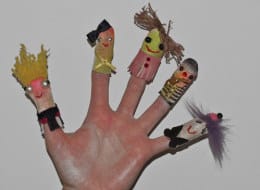The ‘Tween’ Epidemic: Encouraging Kids To Grow Up Too Fast Since 1997
 “Tween” may seem like a relatively new term for parents wrestling Miley Cyrus or Justin Bieber dolls from their kids, but the term is actually coming up on a multi-decade reign.
“Tween” may seem like a relatively new term for parents wrestling Miley Cyrus or Justin Bieber dolls from their kids, but the term is actually coming up on a multi-decade reign.
In Cinderella Ate My Daughter, author Peggy Orenstein reports that the term “tween” was invented as a “marketing contrivance” in the 1980s. However, a pivotal book entitled What Kids Buy: The Psychology of Marketing to Children published in 1997 detailed the “tween” as a area of childhood distinct from childhood or adolescence — but in between and therefore prime for marketing.
The first time I stumbled across the term with in a 1999 issue of Newsweek with an article entitled “The Truth About Tweens.” I remember squinting at the headline assuming that I misread “teen.” Further down the page however, was a profile Maja Kahn — a 12-year-old tween with an ever-changing sense of style.
The age bracket is a bit murky given that a tween can be any child from five years old to 12 depending on which commercials your watching, making the range quite wide. But the development of a new childhood cohort in the name of product pushing is hardly anything new. The term “toddler” was developed in 1936 as a way to sell more clothes to children by distinguishing a new phase of life from infancy. Much like how tweens are being presented to their families today, Depression-era mothers were told that their toddlers were individuals with differences closely tied to sex and gender. Daniel Thomas Cook writes in his book The Commodification of Childhood:
…the toddler is an emerging person whose “likes” and feelings count as much as those of anyone else. Boy toddlers and girl toddlers are different from each other, of course. The girls manifest femininity in “dainty pastels and adorable prints” and boys’ garments are more “tailored,” more mannish for their “poise of mind”…the toddler herself or himself is now a person available for scrutiny by others whose feelings, needed, poise of mind, and choice are being discovered and invoked as legitimate authority. The toddlers are concerned with how they look and are more than aware of the distinction between “proper” and “improper” dress.
Interestingly, a lot of the language Cook uses to convey how toddlers were marketed to mothers is also being used when describing a tween. Children in the tween bracket are often said to have emerging tastes, opinions, and feelings that are both being discovered and asserted particularly with products.
The $43 million industry of tween-dom has assumed the center stage for marketers and parents alike, all curious as to how to cope or sell to this new division of childhood.
Tweens are described by Tina Wells, CEO of Buzz Marketing Group and author of Chasing Youth Culture and Getting it Right, as “what teens were 10 years ago.” She is correct in that tweens have more disposable income than their slightly older brothers and sisters:
Their average weekly allowance is $9, and the bulk of their personal money comes from gifts from parents and grandparents. And there is more money here because parents will spend money on their children. And tween income is truly more disposable. I don’t believe that a teenage income is totally disposable, because mom will say ”˜you have to contribute to your cell phone bill’ or ”˜it’s time you started saving for a car.’ Tweens will say ”˜I’ve got $20 and I’m going to Justice and I’m going to spend it all.’
What is telling about Wells’ observation is not only how tweens have disposable income, but also how independent tween kids are. Tweens are revered by marketers for the web-savvy capabilities, their quick navigation of social media, and their sophisticated use of mobile phones. Children well under the age of Facebook’s age requirement (13 years old) are developing an online presence, communicating in formerly adult arenas: 7.5 million of the 20 million under 18 Facebook users are younger than 13 years of age. With texting, Facebook messages, and online participation, tweens are representative of a smarter, faster generation that has more at their fingertips than kids ever have had before.
Playing to the autonomy of tweens, Orenstein tells me is part of the marketing tactic. Talking up to little girls and not down to them was a big part of the “girl power” push in the 1990s. Efforts to sell girls shirts and accessories that spelled out “sassy” or “pampered princess” sold them independence in the form of materialism. By equating autonomy with shopping, tween girls are being told that their individuality and assertion is expressed through avid shopping.
Independence aside, Orenstein also points to a recent study that determined that while 30% of girls clothing is sexualizing, a vast majority was somewhere in the middle — not fully sexual but not innocently child-like either. The authors of the report concluded:
Our study presents the ‘ambiguously sexualizing’ category of girls’ clothing. The co-occurrence of sexualizing and childlike characteristics makes the sexualization present in girl’s clothing covert. Confused parents might be persuaded to buy the leopard-print miniskirt if it’s bright pink.
Tween clothing has co-opted this problematic common ground of “ambiguously sexualizing” clothing which says a lot about the epidemic, Orenstein explains to me:
So many of those clothes have ”sassy” written on them or are off-the-shoulder or emphasize body parts that are someday going to be sexual. [This] normalizes the idea of sexiness in childhood and that’s what tween [for girls] is really about. Increasingly defining girlhood through appearance and play sexiness…through consumption and self-absorption.
Orenstein also observes that the word “tween” in itself is an attempt to shorten girlhood by introducing commercialized sexuality:
“Tween” really is a term that has been developed to commodify and create a child consumer out of an age of girls. It’s really a way to inappropriately foist a kind of premature sexuality on them because most tween products are about little girls being allegedly more grown up and wanting makeup and clothes that are less child-like and “teenager-ly.” It means sexier and sassier and that’s just what “sassy” is — “sexy” with training wheels.
For tween boys, looking older is also the aim for marketers too. The New York Times noted last year that when it comes to pushing products like body spray and deodorant, the key to getting tween boys is all about insecurity:
Boys themselves, at a younger age, have also become increasingly self-conscious about their appearance and identity. They are trying to tame their twitching, maturing bodies, select from a growing smorgasbord of identities ”” goth, slacker, jock, emo ”” and position themselves with their texting, titillating, brand-savvy female peers, who are hitting puberty ever earlier.
A comment by Wells in the aforementioned interview touches on this very technique:
I think that [tweens] all seek acceptance, and they all find a piece of who they are based on the brands that they like. Brands matter to them and become part of their DNA.
Lyn Mikel Brown, a psychologist at Colby College and an author of Packaging Boyhood, observed that “the products [give] boys the mere illusion of choice,” but in fact advocate a hyper-masculinity for developing boys:
These are just one of many products that cultivate anxiety in boys at younger and younger ages about what it means to man up…to be the kind of boy they’re told girls will want and other boys will respect. They’re playing with the failure to be that kind of guy, to be heterosexual even.
Presenting “independence” and “choices” to children in the form of products or online channels is, according to Orenstein, a “false sense of autonomy.” When reflecting on her own experiences as a mother, she says that autonomy to her means that her daughter will walk to her piano by herself or take part in day came in the woods where she learns physical strength and self-determination.
“That’s the autonomy that our children have lost,” says Orenstein, “and we’re substituting this other medium that is far less healthy.”






